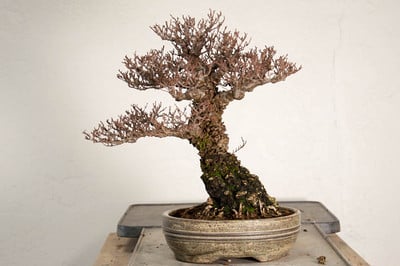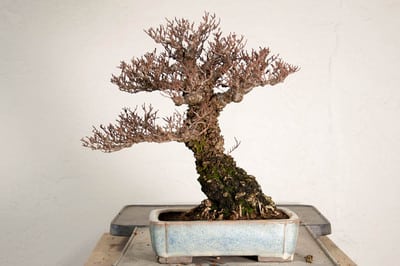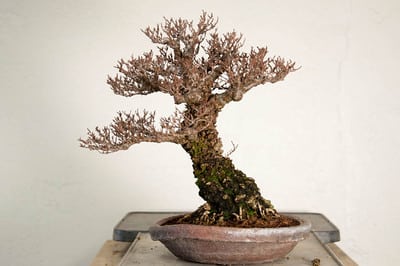Last week I posted three pot alternatives for an old elm. The voting was mixed, but as of last night, pot #1 proved the favorite with 9 votes, while #2 and #3 received roughly 6 and 7 votes respectively. Adding in some Facebook likes for each put #1 further ahead with a total of 48 votes to #2 and #3’s 18 and 19 votes each. At least two votes were cast for none of the above.
One conclusion from the feedback is that none of the pots are perfect. Another might be that each has its strong points. When we began the selection process, I too wished we had more pots to choose from. For me, the predominant characteristic of the tree is age so I wanted a comparably old pot to complement the tree. The elm is both refined, having many fine branches, yet also rough, considering its fissured bark. These contrasting characteristics can make pot selection tricky – and fun.
I think the first pot is a solid, and among these three alternatives, the conservative choice. Glazed ovals are often used for deciduous specimens, and the mottled, muted colors of the Sara Rayner pot suit the tree well. Were it a bit more shallow or possessed of more curves it might do an even better job of highlighting the movement of the tree.

Pot #1 – the top vote getter
The second pot offers the most color, a pale blue, and has the most formal shape, a soft rectangle. The light color provides great contrast against the dark trunk which may or may not provide the desired effect. It would be interesting to see the pot in different colors to see if it’s the shape and/or the color that led people to prefer the other options.

Pot #2
Pot #3 is the least conservative selection. It’s a nanban, typically used for bunjin bonsai or other similarly styled trees in which the movement of the trunk is often the most pronounced characteristic. It’s both wobbly (not symmetrical) and unglazed – two more characteristics less often aligned with deciduous bonsai. On the plus side, the pot has great age and the rough character of the clay complements the trunk well.

Pot #3
So which pot did the owner go with? Pot #3. (“Boo,” “Hiss,” “Hooray!”)
Age won out this year, as did the unconventional. That may not, however, be the case the next time the tree is displayed. And while I’d be comfortable showing the tree (were it mine) in any of these pots, I’ll keep an eye out for more refined antique containers that convey age and compliment the tree’s best characteristics. Maybe a red, unglazed oval with a lip? A white or yellow antique with dark patina? Something in deep green? All could be fun alternatives for the future.
Whether this is an upsetting selection or a confirming one, I invite all to come see the tree and pot live at Bay Island Bonsai’s upcoming exhibit in Oakland, California, two weeks hence.
Subscribe to Bonsai Tonight
New Posts Delivered Every Tuesday and Friday
Mac says
A good exercise Jonas. Thanks for taking the time to make the original post and to follow up with your conclusions and reasoning for the choice you made.
Joe Gutierrez says
I do like your choice ….
Marty says
Based upon your statement about which pot the owner chose, I am wondering if you are or are not the owner. If you are not the owner, which was your choice and why?
Jonas Dupuich says
Hi Marty – I am not the tree’s owner, and were I limited to these three pots I’d be somewhere between #1 and #3. I’d want to consider the rest of the display – as a small tree there will be at least one other tree and pot shown with the elm – and find some more alternatives before making a final decision. I don’t know what tree the elm will be shown with, but I’ll aim to post a pic after the exhibit.